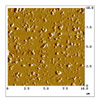Abstract
Background
The diagnosis of chlamydial infection is based on serology. The current gold standard of diagnosis is MIF(microimmunofluorescence), but this modality is subjective and time-consuming. Protein microarray with using a SPR(surface plasmon resonance) sensor has recently been suggested as a method for detecting infection. For developing a protein chip to diagnose chlamydial infection, EBs(elementary bodies) were immobilized on a gold chip and the interaction between an antibody for Chlamydophila pneumoniae and the EBs(elementary bodies) immobilized on the surface of the gold chip was measured by using an SPR sensor.
Methods
For the surface antigen, the EBs of Chlamydophila pneumoniae LKK1 were purified. Charged arrays were prepared by using PDDA(polydiallyldimethylammonium chloride) which has a positive charge. After immobilization of the chlamydial EBs on the PDDA surface, the investigation of the surface was done with using atomic force microscopy. After the antibody for C. pneumoniae was applied on chip, we monitored the SPR wavelength-shift to detect any antigen-antibody interaction with using a self-assembled SPR sensor.
Results
The chlamydial EBs on the positively charged PDDA were visible on the surface with using atomic force microscopy. The SPR wavelength increased after interaction of antibody for C. pneumoniae with the EBs immobilized on charged gold surface. The wavelength-shift was correlated with the concentration of antigens.
Figures and Tables
Figure 2
Atomic force microscopy image of C. pneumoniae(EB) on PDDA (polydiallyldimethylammonium chloride) gold surface

References
1. File TM Jr, Tan JS, Plouffe JF. The role of atypical pathogens: Mycoplasma pneumoniae, Chlamydia pneumoniae and Legionella pneumophila in respiratory infection. Infect Dis Clin North Am. 1998. 12:569–592.
2. Lee SJ, Lee MG, Jeon MJ, Jung KS, Lee H, Kishimoto T. Atypical pathogens in adult patients admitted with community-acquired pneumonia in Korea. Jpn J Infect Dis. 2002. 55:157–159.
3. Bachmaier K, Neu N, de la Maza LM, Pal S, Hessel A, Penninger JM. Chlamydia infections and heart disease linked through antigenic mimicry. Science. 1999. 283:1335–1339.
4. Falck G, Gnarpe J, Hansson LO, Svardsudd K, Gnarpe H. Comparison of individuals with and without specific IgA antibodies to Chlamydia pneumoniae. Chest. 2002. 122:1587–1593.
5. Dowell SF, Peeling RW, Boman J, Carlone GM, Fields BS, Guarner J, et al. Standardizing Chlamydia pneumoniae assays: recommendations from the centers for disease control and prevention and the laboratory centre for disease control. Clin Infect Dis. 2001. 33:492–503.
6. File TM. Community-acquired pneumonia. Lancet. 2003. 362:1991–2001.
7. Campbell CJ, Ghazal P. Molecular signature for diagnosis of infection: application of microarray technology. J Appl Microbiol. 2004. 96:18–23.
8. Mezzasoma L, Bacarese-Hamilton T, di Cristana M, Rossi R, Bistoni F, Crisanti A. Antigen microarrays for serodiagnosis of infectious diseases. Clin Chem. 2002. 48:121–130.
9. Jongerius-Gortemarker BG, Goverde RL, van Knapen F, Bergwerff AA. Surface plasmon resonance detection of serum antibodies against Salmonella enteritidis and Salmonella typhimurium. J Immunol Methods. 2002. 266:33–44.
10. Bokken GC, Corbee RJ, van Knapen F, Bergwerff AA. Immunochemical detection of Salmonella group B, D and E using an optical surface plasmon resonance biosensor. FEMS Microbiol Lett. 2003. 222:75–82.
11. MacBeath G, Schreiber SL. Printing proteins as microarrays for high-throughput function determination. Science. 2000. 289:1760–1763.
12. Zhu H, Snyder M. Protein chip technology. Curr Opin Chem Biol. 2003. 7:55–63.
13. Lee SJ, Nam EC, Won J, Park WS, Kim WJ, Han SS, et al. Characterization of the first Korean isolate of a Chlamydia pneumoniae strain. Jpn J Infect Dis. 2003. 56:62–64.
14. Yuk JS, Yi SJ, Lee HG, Kim YM, Ha KS. Characterization of surface plasmon resonance wavelength by changes of protein concentration on protein chips. Sens Actuators B Chem. 2003. 94:161–164.
15. Hermann C, Gueinzius K, Oehme A, von Aulock S, Straube E, Hartung T. Comparison of quantitative and semiquantitative ELISA for IgG against C. pneumoniae to a MIF test for use with patients with respiratory tract infections. J Clin Microbiol. 2004. 42:2476–2479.
16. Lee HY, Kim WJ. ELISA for antibodies against Chlamydia pneumoniae compared with MIF test with patients with chronic cough. Tuberc Respir Dis. 2005. 59:47–52.
17. Menendez R, Cordoba J, de la Cuadra P, Cremades MJ, Lopez-Hontagas JL, Salavert M, et al. Value of the polymerase chain reaction assay in noninvasive respiratory samples for diagnosis of community-acquired pneumonia. Am J Respir Crit Care Med. 1999. 159:1868–1873.
18. Yuk JS, Ha KS. Proteomic applications of surface plasmon resonance biosensor: analysis of protein arrays. Exp Mol Med. 2005. 37:1–10.
19. Wang D, Coscoy L, Zylberberg M, Avila PC, Boushey HA, Ganem D, et al. Microarray-based detection and genotyping of viral pathogens. Proc Natl Acad Sci U S A. 2002. 99:15687–15692.
20. Lu DD, Chen SH, Zhang SM, Zhang ML, Zhang W, Bo XC, et al. Screening of specific antigens for SARS clinical diagnosis using a protein microarray. Analyst. 2005. 130:474–482.
21. Sachse K, Hotzel H, Slickers P, Ellinger T, Ehricht R. DNA microarray-based detection and identification of Chlamydia and Chlamydophila spp. Mol Cell Probes. 2005. 19:41–50.
22. Angenendt P, Glokler J, Murphy D, Lehrach H, Cahill DJ. Toward optimized antibody microarrays: a comparison of current microarray support materials. Anal Biochem. 2002. 309:253–260.
23. Vance DW Jr, Hatch TP. Surface properties of Chlamydia psittaci. Infect Immun. 1980. 29:175–180.
24. Yi SJ, Yuk JS, Jung SH, Zhavnerko GK, Kim YM, Ha KS. Investigation of selection protein immobilization on charged protein array by wavelength interrogation-based SPR sensor. Mol Cells. 2003. 15:333–340.
25. Yuk JS, Jung SH, Jung JW, Hong DG, Han JA, Kim YM, et al. Analysis of protein interactions on protein arrays by a wavelength interrogation-based surface plasmon resonance biosensor. Proteomics. 2004. 4:3468–3476.
26. McDonnell JM. Surface plasmon resonance: towards an understanding of the mechanisms of biological molecular recognition. Curr Opin Chem Biol. 2001. 5:572–577.
27. Hifumi E, Kubota N, Niimi Y, Shimizu K, Egashira N, Uda T. Elimination of ingredients effect to improve the detection of anti HIV-1 p24 antibody in human serum using SPR apparatus. Anal Sci. 2002. 18:863–867.




 PDF
PDF ePub
ePub Citation
Citation Print
Print





 XML Download
XML Download